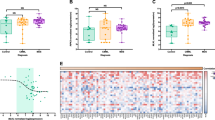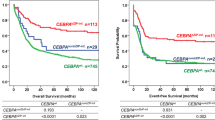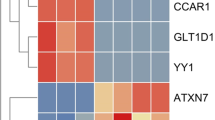Abstract
The iron chelator deferasirox is widely used in patients with iron overload. Patients with low-grade myelodysplastic syndromes (MDS) get transfusion dependency and need to be treated with deferasirox to avoid iron overload. Moreover, in some patients an increase in both erythroid and platelets have been observed after deferasirox therapy. However, the mechanisms involved in these clinical findings are poorly understood. The aim of this work was to analyze, in patients treated with deferasirox, the changes in the gene-expression profile after receiving the treatment. A total of 15 patients with the diagnosis of low-grade MDS were studied. Microarrays were carried out in RNA from peripheral blood before and after 14 weeks of deferasirox therapy. Changes in 1457 genes and 54 miRNAs were observed: deferasirox induced the downregulation of genes related to the Nf kB pathway leading of an overall inactivation of this pathway. In addition, the iron chelator also downregulated gamma interferon. Altogether these changes could be related to the improvement of erythroid response observed in these patients after therapy. Moreover, the inhibition of NFE2L2/NRF2, which was predicted in silico, could be playing a critical role in the reduction of reactive oxygen species (ROS). Of note, miR-125b, overexpressed after deferasirox treatment, could be involved in the reduced inflammation and increased hematopoiesis observed in the patients after treatment. In summary this study shows, for the first time, the mechanisms that could be governing deferasirox impact in vivo.
This is a preview of subscription content, access via your institution
Access options
Subscribe to this journal
Receive 6 print issues and online access
$259.00 per year
only $43.17 per issue
Buy this article
- Purchase on Springer Link
- Instant access to full article PDF
Prices may be subject to local taxes which are calculated during checkout



Similar content being viewed by others
References
Gattermann N. Iron overload in myelodysplastic syndromes (MDS). Int J Hematol. 2018;107:55–63.
Cario H, Janka-Schaub G, Janssen G, Jarisch A, Strauss G et al. Recent developments in iron chelation therapy. Klin Padiatr. 2007;219:158–65.
Kushner JP, Porter JP, Olivieri NF. Secondary iron overload. Hematol Am Soc Hematol Educ Progr. 2001:47–61.
Olivieri NF, Brittenham GM. Iron-chelating therapy and the treatment of thalassemia. Blood. 1997;89:739–61.
Olivieri NF, Sabouhanian A, Gallie BL. Single-center retrospective study of the effectiveness and toxicity of the oral iron chelating drugs deferiprone and deferasirox. PLoS ONE. 2019;14:e0211942.
Piciocchi A, Sargentini V, Cotugno F, Bontempi K, Beltrami G, Di Tucci AA, et al. Update of the GIMEMA MDS0306 study: deferasirox for lower risk transfusion-dependent patients with myelodysplastic syndromes. Eur J Haematol. 2019;102:442–3.
Musto P, Maurillo L, Simeon V, Poloni A, Finelli C, Balleari E, et al. Iron-chelating therapy with deferasirox in transfusion-dependent, higher risk myelodysplastic syndromes: a retrospective, multicentre study. Br J Haematol. 2017;177:741–50.
Mills KI, Kohlmann A, Williams PM, Wieczorek L, Liu W, Li R, et al. Microarray-based classifiers and prognosis models identify subgroups with distinct clinical outcomes and high risk of AML transformation of myelodysplastic syndrome. Blood. 2009;114:1063–72.
del Rey M, O’Hagan K, Dellett M, Aibar S, Colyer HAA, Alonso ME, et al. Genome-wide profiling of methylation identifies novel targets with aberrant hypermethylation and reduced expression in low-risk myelodysplastic syndromes. Leukemia. 2013;27:610–8.
Chen J, Lu W-Y, Zhao M-F, Cao X-L, Jiang Y-Y, Jin X, et al. Reactive oxygen species mediated T lymphocyte abnormalities in an iron-overloaded mouse model and iron-overloaded patients with myelodysplastic syndromes. Ann Hematol. 2017;96:1085–95.
Messa E, Carturan S, Maffè C, Pautasso M, Bracco E, Roetto A, et al. Deferasirox is a powerful NF-kappaB inhibitor in myelodysplastic cells and in leukemia cell lines acting independently from cell iron deprivation by chelation and reactive oxygen species scavenging. Haematologica. 2010;95:1308–16.
Ohyashiki JH, Kobayashi C, Hamamura R, Okabe S, Tauchi T, Ohyashiki K. The oral iron chelator deferasirox represses signaling through the mTOR in myeloid leukemia cells by enhancing expression of REDD1. Cancer Sci. 2009;100:970–7.
Vardiman JW, Thiele J, Arber DA, Brunning RD, Borowitz MJ, Porwit A, et al. The 2008 revision of the World Health Organization (WHO) classification of myeloid neoplasms and acute leukemia: rationale and important changes. Blood. 2009;114:937–51.
Bolstad BM, Irizarry RA, Astrand M, Speed TP. A comparison of normalization methods for high density oligonucleotide array data based on variance and bias. Bioinformatics. 2003;19:185–93.
Huang DW, Sherman BT, Lempicki RA. Systematic and integrative analysis of large gene lists using DAVID bioinformatics resources. Nat Protoc. 2009;4:44–57.
Huang DW, Sherman BT, Lempicki RA. Bioinformatics enrichment tools: paths toward the comprehensive functional analysis of large gene lists. Nucleic Acids Res. 2009;37:1–13.
Carmona-Saez P, Chagoyen M, Tirado F, Carazo JM, Pascual-Montano A. GENECODIS: a web-based tool for finding significant concurrent annotations in gene lists. Genome Biol. 2007;8:R3.
List AF, Baer MR, Steensma DP, Raza A, Esposito J, Martinez-Lopez N, et al. Deferasirox reduces serum ferritin and labile plasma iron in RBC transfusion-dependent patients with myelodysplastic syndrome. J Clin Oncol. 2012;30:2134–9.
Gattermann N, Finelli C, Della Porta M, Fenaux P, Stadler M, Guerci-Bresler A, et al. Hematologic responses to deferasirox therapy in transfusion-dependent patients with myelodysplastic syndromes. Haematologica. 2012;97:1364–71.
Angelucci E, Santini V, Di Tucci AA, Quaresmini G, Finelli C, Volpe A, et al. Deferasirox for transfusion-dependent patients with myelodysplastic syndromes: safety, efficacy, and beyond (GIMEMA MDS0306 Trial). Eur J Haematol. 2014;92:527–36.
Banerjee A, Mifsud NA, Bird R, Forsyth C, Szer J, Tam C, et al. The oral iron chelator deferasirox inhibits NF-κB mediated gene expression without impacting on proximal activation: implications for myelodysplasia and aplastic anaemia. Br J Haematol. 2015;168:576–82.
Lyle L, Hirose A. Iron overload in myelodysplastic syndromes: pathophysiology, consequences, diagnosis, and treatment. J Adv Pract Oncol. 2018;9:392–405.
Meunier M, Ancelet S, Lefebvre C, Arnaud J, Garrel C, Pezet M, et al. Reactive oxygen species levels control NF-κB activation by low dose deferasirox in erythroid progenitors of low risk myelodysplastic syndromes. Oncotarget. 2017;8:105510–24.
Jiménez‐Solas T, López‐Cadenas F, Aires‐Mejía I, Caballero‐Berrocal JC, Ortega R, Redondo AM, et al. Deferasirox reduces oxidative DNA damage in bone marrow cells from myelodysplastic patients and improves their differentiation capacity. Br J Haematol. 2019;187:93–104.
Anguita E, Candel FJ, Chaparro A, Roldán-Etcheverry JJ. Transcription factor GFI1B in health and disease. Front Oncol. 2017;7:54.
Nolte F, Höchsmann B, Giagounidis A, Lübbert M, Platzbecker U, Haase D, et al. Results from a 1-year, open-label, single arm, multi-center trial evaluating the efficacy and safety of oral Deferasirox in patients diagnosed with low and int-1 risk myelodysplastic syndrome (MDS) and transfusion-dependent iron overload. Ann Hematol. 2013;92:191–8.
Molteni A, Riva M, Pellizzari A, Borin L, Freyrie A, Freyre A, et al. Hematological improvement during iron-chelation therapy in myelodysplastic syndromes: the experience of the «Rete Ematologica Lombarda». Leuk Res. 2013;37:1233–40.
Morales-Mantilla DE, King KY. The role of interferon-gamma in hematopoietic stem cell development, homeostasis, and disease. Curr Stem Cell Rep. 2018;4:264–71.
Tili E, Michaille J-J, Cimino A, Costinean S, Dumitru CD, Adair B, et al. Modulation of miR-155 and miR-125b levels following lipopolysaccharide/TNF-alpha stimulation and their possible roles in regulating the response to endotoxin shock. J Immunol. 2007;179:5082–9.
Chaudhuri AA, So AY-L, Sinha N, Gibson WSJ, Taganov KD, O’Connell RM, et al. MicroRNA-125b potentiates macrophage activation. J Immunol. 2011;187:5062–8.
Park H, Huang X, Lu C, Cairo MS, Zhou X. MicroRNA-146a and microRNA-146b regulate human dendritic cell apoptosis and cytokine production by targeting TRAF6 and IRAK1 proteins. J Biol Chem. 2015;290:2831–41.
O’Connell RM, Chaudhuri AA, Rao DS, Gibson WSJ, Balazs AB, Baltimore D. MicroRNAs enriched in hematopoietic stem cells differentially regulate long-term hematopoietic output. Proc Natl Acad Sci USA. 2010;107:14235–40.
Ooi AGL, Sahoo D, Adorno M, Wang Y, Weissman IL, Park CY. MicroRNA-125b expands hematopoietic stem cells and enriches for the lymphoid-balanced and lymphoid-biased subsets. Proc Natl Acad Sci USA. 2010;107:21505–10.
Acknowledgements
This work was partially supported by grants from the Spanish Fondo de Investigaciones Sanitarias PI15/01471, PI17/01741, PI18/01500, Instituto de Salud Carlos III (ISCIII), European Regional Development Fund (ERDF) “Una manera de hacer Europa”, “Consejería de Educación, Junta de Castilla y León” (SA271P18), “Proyectos de Investigación del SACYL”, Spain: GRS 1847/A/18, GRS 1653/A17, GRS 1850/A/18, “Fundación Memoria Don Samuel Solórzano Barruso”, by grants (RD12/0036/0069) from Red Temática de Investigación Cooperativa en Cáncer (RTICC) and Centro de Investigación Biomédica en Red de Cáncer (CIBERONC CB16/12/00233). JMHS and AERV are supported by a research grant by FEHH (“Fundación Española de Hematología y Hemoterapia”). We are grateful to I. Rodríguez, S. González, T. Prieto, M. Á. Ramos, AM, A. Díaz, A. Simón, M. del Pozo, V. Gutiérrez, and S. Pujante, Sandra Santos and Cristina Miguel from Cancer research Center of Salamanca, Salamanca, for their technical assistance.
Author information
Authors and Affiliations
Contributions
JMHS designed the experiment, interpreted the results and performed bioinformatic analysis; DAL performed bioinformatic analysis; EL, MA, and MDR contributed to the interpretation of the results; TG, MDC, AAM, RP, SE, BA, and JMHR performed patient selection and provided clinical data; JMHR and AERV contributed to the interpretation of the results and wrote the paper. All authors revised the paper.
Corresponding author
Ethics declarations
Conflict of interest
The authors declare that they have no conflict of interest.
Additional information
Publisher’s note Springer Nature remains neutral with regard to jurisdictional claims in published maps and institutional affiliations.
Supplementary information
Rights and permissions
About this article
Cite this article
Sánchez, J.M.H., Lumbreras, E., Díez-Campelo, M. et al. Genome-wide transcriptomics leads to the identification of deregulated genes after deferasirox therapy in low-risk MDS patients. Pharmacogenomics J 20, 664–671 (2020). https://doi.org/10.1038/s41397-020-0154-5
Received:
Revised:
Accepted:
Published:
Issue Date:
DOI: https://doi.org/10.1038/s41397-020-0154-5



